
The Korea Railroad Corporation is the national railway operator in South Korea. It is branded as KORAIL (코레일) and changed its official Korean name in November 2019. Currently, KORAIL is a public corporation, managed by Ministry of Land, Infrastructure and Transportation.

The Gyeongbu line (Gyeongbuseon) is a railway line in South Korea and is considered to be the most important and one of the oldest in the country. It was constructed in 1905, connecting Seoul with Busan via Suwon, Daejeon, and Daegu. It is by far the most heavily travelled rail line in South Korea.

The Gyeongin Line (Gyeonginseon) is a railway mainline in South Korea, currently connecting Guro station in Seoul and Incheon. Commuter services along the line through operates into Seoul Subway Line 1.
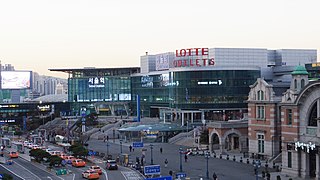
Seoul Station (Korean: 서울역) is a major railway station in Seoul, the capital of South Korea. The station is served by the Korail Intercity Lines and the commuter trains of the Seoul Metropolitan Subway.

Seoul Subway Line 1 of the Seoul Metropolitan Subway is a rapid transit and commuter rail line which links central Seoul, South Korea to Yeoncheon in the northeast, Incheon in the southwest, and Sinchang via Suwon and Cheonan in the south. The central underground portion of Line 1, running underneath Sejongno, Jongno, and Wangsan-ro avenues along Seoul's traditional downtown area, is the oldest subway-operated section in the Seoul Metropolitan Subway system. Its branches and services cover a large part of the Seoul Capital Area; totaling 218.3 km (135.6 mi) in route length.
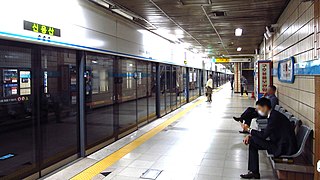
Sinyongsan station is a station on the Seoul Subway Line 4 in Hangang-daero, Yongsan-gu, Seoul. Although not connected to this station by a transfer passageway, Yongsan station on Line 1 is a short walk away. The southwestern section of Yongsan Garrison can be accessed easily from this station. Its station subname is AMOREPACIFIC, and AMOREPACIFIC is located nearby.

Yeongdeungpo District is an administrative district in southwest Seoul, South Korea. Although the origin of the name is uncertain, the first two syllables are thought to be from "yeongdeung" (靈登) or "divine ascent", a shamanic rite. The third syllable is "po", representing the bank of a river (浦), referring to the district's position on the Han River. The 2006 population was 408,819.

The Commuter Train was a class of short-run commuter trains operated by Korail, the national railroad of South Korea. They operated once or twice daily in each direction, along a few tens of kilometers of track. They provided an important function for many smaller rural communities, which often lack good transit connections. Commuter Train operations on the Gyeongwon line was temporarily suspended its operation on April 1, 2019, due to the construction and partial electrification of the line for the Soyosan-Yeoncheon extension of Seoul Subway Line 1. They were permanently suspended on December 16, 2023, after the opening of the Yeoncheon extension, and due to the old age of CDC trains. This effectively ended regular train service north of Yeoncheon Station, with the provincial government of Cheolwon lodging a complaint. Commuter trains last operated on the Gwangju Line in Gwangju between GwangjuSongjeong and Gwangju station, from January 1, 2020, until December 17, 2023, permanently being phased out due to the old age of CDC trains.

Sindorim station is a station on Seoul Subway Line 1 and Line 2 (underground). It is also the southeastern terminus of Line 2's Sinjeong Branch to Kkachisan. The station is located at the northern edge of Sindorim-dong, Guro-gu, Seoul, on the border with Yeongdeungpo-gu.

Suwon Station is a railway station in the city of Suwon, South Korea. The station was completely redeveloped in 2002 and 2003, and is now integrated with the Aekyung Shopping Mall. This station serves Inter-city railway Gyeongbu Line KTX, ITX-Saemaeul and Mugunghwa will stop. Also Line 1, Suin–Bundang Line of the Seoul subway will stop. And this station is an important hub in southern Gyeonggi Province.

The Saemaeul-ho, formerly known as the Saemaul-ho and Saemaul Express, is a class of train operated by Korail, the national railroad of South Korea, since February 8, 1969. Before the introduction of the KTX express trains, the Saemaeul-ho was the fastest class of trains in South Korea, making the journey from Seoul to Busan in less than 5 hours. Saemaeul trains operated on several lines, but they now only operate on the Janghang Line.

Yeongdeungpo station is a ground-level railway station in Seoul, South Korea. The station is located in Yeongdeungpo Dong, Yeongdeungpo-gu, and is a stop on the Gyeongbu Line, Honam Line and Seoul Subway Line 1. The station is integrated into the Yeongdeungpo Lotte Department Store. Located in the station are Lotteria, Dunkin' Donuts, Krispy Kreme, and KFC.
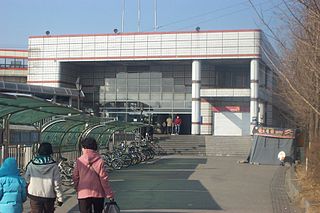
Guil Station (Korean: 구일역) is a subway station in Seoul, South Korea, that serves Seoul Subway Line 1. The name of this station comes from its location within Guro 1 -dong. Dongyang Mirae University is located nearby.
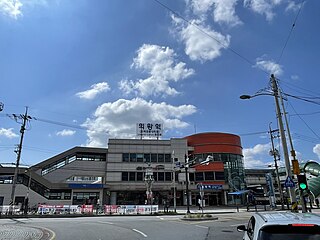
Uiwang Station is a ground-level metro station on line 1 of the Seoul Subway in Uiwang, South Korea. The station's four exits offer access to the Korea National University of Transportation, the Korean Railroad Museum and the Bugok Dong area of Uiwang. Travel time from Uiwang Station to Seoul Station on Line 1 is 50 minutes.

Pyeongtaek Station is the main train station serving the city of Pyeongtaek, South Korea. It is on the Gyeongbu Line and Pyeongtaek Line and is also served by Seoul Subway Line 1. It is not a KTX station, and the KTX does NOT stop here and there is a ticket counter for KORAIL where you can buy KTX tickets leaving from KTX Stations in Asan (south) and Suwon (north). Pyeongtaek Station attaches to AK Plaza. A department store brand with additional locations in other areas of Korea. The Pyeongtaek Station / AK Plaza building also offers restaurants, grocery shopping, and a movie theater. The cinema is located on the 8th floor of AK Plaza and is a CJ CGV multi-screen facility with a 4-D screen. The station is also located in Pyeongtaek-dong, Pyeongtaek-si so you can find many stores and restaurants out Exit 1.

Doksan Station is a station on Line 1 of the Seoul Subway. It is an above-ground station located in southwestern Seoul, with service between Uijeongbu and Suwon/Cheonan.
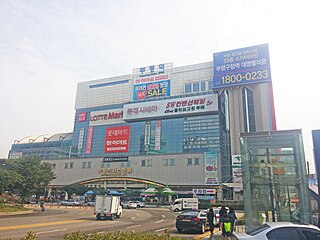
Bupyeong station is a subway station located in Bupyeong District, Incheon, South Korea. This station is on the Seoul Subway Line 1 and Incheon Subway Line 1. It is one of the busiest stations on the Incheon line because of its central location and its connection to the Seoul line.

Oido station is a subway station on Seoul Subway Line 4 and the Suin–Bundang Line in Siheung, South Korea. It is the current southwestern terminus of Seoul Subway Line 4 located almost 30 kilometers southwest of Seoul, connecting Oido to other parts of Korea. A commuter rail trip between this station and Seoul Station takes over an hour, and a train servicing depot is located nearby. The name of the station was decided by the surrounding area Oido island.

Anyang Station is a ground-level subway station on Line 1 of the Seoul Metropolitan Subway. The station is located in the Anyang One neighborhood, in Manan District, Seoul. The station's sole exit offers access to Enter-6 Mall, which occupies the same building. Travel time from Anyang Station to Seoul Station on Line 1 is approximately 40 minutes. Anyang Station is the main station in Anyang, but there are another six stations in Anyang, namely Beomgye, Pyeongchon and Indeogwon on Line 4, and Myeonghak, Gwanak and Seoksu on Line 1, though the latter's platforms lie within Seoul. It is connected with Lotte Dapartment Store.

Asan Station is a railway station on the Janghang Line which is also served by Line 1 of the Seoul Subway. Its located in Baebang-eup, Asan-si, Chungcheongnam-do, South Korea. Meanwhile, is served by all Saemaeul-ho and Mugunghwa-ho services on the Janghang Line.






















